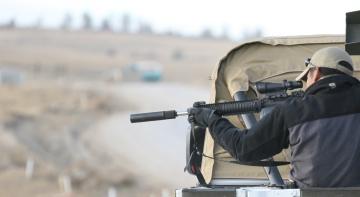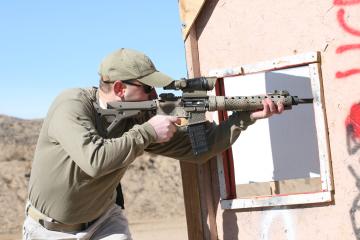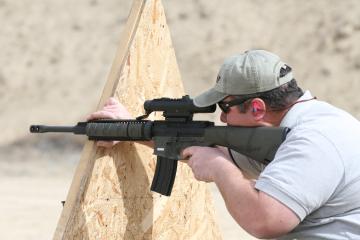
 The TA11 ACOG has more eye relief and requires less precise eye placement to obtain a sight picture
compared to the TA31 ACOG in use by the US Military.
At very close range, Type II optics are much slower to acquire a sight picture than the Type I red
dots. They can be stretched to 600 to 800 yards provided the target is large and the reticle
provides sufficient bullet-drop compensation (BDC) features. These optics provide good target
spotting and identification. Close-range speed can be improved by the addition of a brightly
illuminated reticle center, since the brain is drawn quickly to bright objects. The TA31 and TA11
ACOGs have this feature, as does the Schmidt and Bender Short Dot.
Low-power variable-magnification Type II optics improve close-range target acquisition speed at
their lowest magnification setting; the closer to true 1x the better. The goal of these
variable-power scopes is to provide the speed of the Type I optic, but still the target ID and
distance capabilities of the Type II optics. The price for this flexibility is paid in increased
purchase cost, less durability, and more weight and bulk on the carbine.
For small but practical targets, such as a ten-inch plates, the Type II optic will limit engagement
distance to 350-450 yards, where the coarse BDC, thick reticle lines, and low magnification inhibit
the ability to achieve the correct point of aim and a clear sight picture.

 Although the 3.5x magnification of the TA11 ACOG is slower for close-range engagements, with
training and practice the difference can be slight. The author hammers a target at 20 yards while
on the move.
In practical shooting competition such as three-gun, the 3.5x TA11 ACOG is one of the most common
choices. It is chosen over the 4x TA31 ACOG because the TA11 provides longer eye relief (2.4-inch
vs. 1.5-inch), require less precise eye positioning to obtain a sight picture, and takes up less of
the shooter's natural field of view when shooting with both eyes open. Both have the fiber optic
and tritium-lit reticle which aids acquisition speed. The TA11 is easier to use when on the move or
when shooting from awkward and improvised positions. The US Military uses the TA31 ACOG, however,
shooters would be better served with the TA11 model. Market price on the TA11 and TA31 ACOGs are
around $1000.
Schmidt and Bender's 1.1-4x20 mm Short Dot provides almost true unity magnification at the low end,
and useful four power magnification at the top end. Its first focal-plane reticle has hash marks
every one-half mil, and a center illumination dot which is quite bright at the 11 brightness
setting. The Short Dot retails for about $2200, and almost perfectly bridges the gap between
Type I and II applications.


The killer
feature of the S&B Short Dot is that it is almost as fast and flexible as 1x red-dot optics at close
range and one the move.
Trijicon's 1.25-4x24 mm AccuPoint (TR21) shares the same fiber-optic and tritium reticle
illumination as the ACOG, but can be dialed down in magnification to help speed at close range. Its
reticle has no BDC features so shooting past the carbine's point-blank range will be difficult
without a way to specify elevation holdover. The TR21 is a good deal at about $575.
Leupold's Mark 4 1-3x14 mm CQ/T has close to unity magnification at the low end, but only 3x at the
top, less than the Short Dot, TR21, TA31, and TA11. The reticle has no BDC features and its
illumination is not bright enough to stand out in daylight. The CQ/T is criticized for bulky size
and narrow field of view. Market price on the CQ/T is about $700. The Leupold Mark 4 1.5-5x20mm
MR/T is similar in concept to the Trijicon TR21 and the Short Dot, though its low end magnification
is higher than either. It does have a reticle-based BDC for longer shots. The 1.5-5x20mm MR/T sells
for about $850.

 The Leupold CQ/T has been criticized for being large and it lacks bullet-drop compensation features,
however, it can still be used to make hits at 300 to 400 yards using Kentucky hold-over.
The Elcan SpecterDR is a 1x or 4x optic, switchable with a cam lever on the left-hand side of the
optic. Like the older Elcan, elevation and windage adjustments are external to the optic itself.
The reticle is essentially identical to a TA01 ACOG, with an illuminated center. The SpecterDR is
a promising concept, however, the built-in ARMS mount makes it a no-go for many would-be customers
because the throw levers are known for eventually coming loose. Market price is about $1600.
In the Type II or DMR role, the Short Dot is the most versatile but also the most expensive choice,
more than twice the cost of any other. The Trijicon TA11 ACOG has bomb-proof construction, a
compact package, good reliability, fast target acquisition due to its super-bright reticle, and,
though fixed power (3.5x), is the second best choice for intermediate engagements. It gives up a
little speed at very close-range engagements.
|